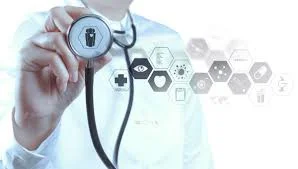“Predicting rain doesn’t count. Building arks does.
”
THE TRUE BENEFITS of artificial intelligence, machine learning, natural language processing, robotics, and data will be seen when we move away from our current fee-for-service model of healthcare and towards preventative medicine. The idea is simple: instead of waiting for people to get sick and then trying to treat their symptoms, we can head illnesses off at the pass and stop them from becoming a problem in the first place. It might cost a little more up front, but it could save the healthcare industry a huge amount of money in the long run.
Predictive medicine and preventative medicine are similar but different, in that predictive medicine revolves around identifying what’s likely to happen in the future while preventative medicine involves taking active steps based upon these insights. Predictive medicine will naturally lead to preventative medicine, but it’s predictive medicine I want to talk about right now because artificial intelligence essentially relies on predictions derived from massive amounts of data. The more data that’s fed into the algorithm, the better the predictions become.
The interesting thing is that once we get into the business of predicting health, the industry will be forced to radically redefine itself. As new opportunities arise for health maintenance and prevention, so too will the number of services that are available to us.
There are different ways of approaching predictive medicine, from genomics and proteomics to cytomics and genetics. Genetic testing is arguably the most powerful way of identifying potential diseases decades prior to any actual symptoms developing. In some circumstances, it could even be used to identify potential diseases when babies are in the womb so that people who are more susceptible to disease can take preventative measures and modify their behaviors to avoid potential risk factors. This is where predictive medicine becomes preventative medicine.
The overall aim of predictive medicine is to flag risk factors so that physicians and patients can work together to reduce the chances of future problems. For example, patients with a greater risk of heart attacks and irregularities could receive more regular EKGs and cardiologist appointments. It’s intended for both healthy people and for those with existing diseases, but the goal in both cases remains the same: to use predictions and preventative medicine to give people the best possible quality of life.
Predictive Medicine Examples
There’s no shortage of great examples of predictive medicine, and I’ve already shared many of them elsewhere in both my books and my articles. Here are just a few more to help you to wrap your head around some of the potentials that predictive medicine has to offer.
NEWBORN SCREENING: Typically conducted shortly after birth, the goal is to identify potential genetic disorders as early as possible. This is currently one of the most widespread forms of predictive medicine thanks to US state law which mandates taking blood samples of every newborn baby across every state.
RISK TESTING: This approach to predictive medicine looks to see whether patients have risk factors that could exacerbate the likelihood of a disease. For example, a 50-year-old heavy smoker is more likely to suffer from lung cancer, emphysema and other diseases than a 20-year-old non-smoker.
DIAGNOSTIC TESTING: When a doctor has made a tentative diagnosis, diagnostic testing is used to confirm or refute the diagnosis. For example, a celiac disease blood test could be carried out to determine whether a patient is suffering from gluten intolerance or whether some other issue is the root cause.
PRECONCEPTION TESTING: The idea here is to test parents before they start trying to conceive a child to identify whether either (or both!) parents carry a gene mutation that could cause genetic disorders. Parents can then make a more educated decision on whether to try for a child or not based on any potential risk factors.
DIRECT TO CONSUMER TESTING: This relatively new phenomenon is characterized by services like 23AndMe which allow people to test their genes with no need for a physician to act as a go-between. These tests may not be as comprehensive as other types of predictive medicine, but they do have the advantage of increased accessibility and greater privacy. Plus they return power to the hands of the consumer — which in this case is the patient.
